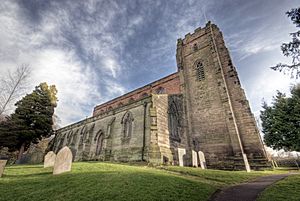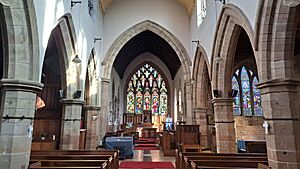Church of St Chad, Lichfield facts for kids
Quick facts for kids Church of St Chad, Lichfield |
|
|---|---|
 |
|
| 52°41′22″N 1°49′15″W / 52.689373°N 1.820925°W | |
| Location | Lichfield, Staffordshire |
| Country | England |
| Denomination | Anglican |
| Website | The Church of St Chad |
| Architecture | |
| Functional status | Active |
| Heritage designation | Grade II* |
| Designated | 05.02.1952 |
| Architectural type | Church |
| Style | Early English, Gothic |
| Specifications | |
| Materials | Sandstone & Brick |
| Administration | |
| Parish | Lichfield |
| Diocese | Lichfield |
| Province | Canterbury |
The Church of St Chad is an old church located in the Stowe area of Lichfield, Staffordshire, in the United Kingdom. It's a very important building, listed as Grade II*. The church stands north of Stowe Pool on St Chad's Road. Its history goes back to the 12th century, but it has been changed and added to many times since then.
Contents
History of St Chad's Church
Chad came to Lichfield around 669 CE. He later became the Bishop of Lichfield. He wanted a quiet place to pray and settled in a wood. He lived like a hermit by a spring. From this spot, he would preach and baptize people in the spring. Many believe this spring and Chad's home were in the churchyard we see today.
A monastery, a place for monks, was built near the spring. It was called the station of St Chad. This was around the time St Chad lived. Sadly, nothing is left of this first Saxon monastery.
In the 12th century, the monastery was rebuilt as a stone church. It had a main area (nave), two side aisles, and a special area for the altar (chancel). The main entrance was where the tower is now. Some of the oldest parts you can still see are the rounded arches of the Norman windows. These are in the south aisle.
During the 13th century, the church got a new roof. The walls were made taller, and the old Norman windows were replaced. New, pointed windows in the Early English style were added. The south arcade, which is a row of arches with octagonal pillars, is also from this time. So are the chancel and the west doorway.
The tall tower on the west side was built in the 14th century. It was made to hold the church bells. The large east window in the chancel, with its beautiful stone patterns, was also built then. The font, used for baptisms, is still the original one from this period.
In 1323, an Irish traveler named Symon Semeonis visited the church. He was on his way to the Holy Land. He wrote that it was "a most beautiful church... with most lofty stone towers, and splendidly adorned."
During the Reformation, many of the church's valuable items were taken away. Later, during the English Civil War, soldiers used the church. It was badly damaged, and the roof had to be rebuilt. At this time, a red brick section was added above the main windows. The single roof was replaced with three separate roofs.
In 1840, the north aisle was taken down and rebuilt. It was done in a Victorian Gothic style. More work happened in 1862. The chancel and its arch were restored. A vestry (a room for clergy) was added to the north side. A porch was added to the south. Windows and stained glass were also repaired. The east end of the south aisle you see today is from this time.
St Chad's Well
St Chad's Well is in the churchyard, to the north-west of the church. It was built over a special spring. People believe St Chad prayed on a stone here. He also baptized people and healed illnesses with the water. By the 16th century, many people visited it as a place of pilgrimage.
In the 1830s, a local doctor named James Rawson helped improve the well's water supply. He also had a fancy stone building put over the well. By the early 1920s, the water started to dry up. So, the well was lined with brick, and a pump was added. The stone building was taken down in the 1950s. It was replaced with the simple wooden structure and tiled roof you see today.
The well is still a popular place for people to visit and pray. This includes Anglicans and Catholics. It is traditionally decorated with flowers and greenery on Maundy Thursday. The vines growing over the canopy are a Christian symbol. They represent the wine used in the Eucharist.
Other Features of the Church
Monuments and Memorials
Inside the church, there are monuments with connections to Samuel Johnson. He was a famous writer. One monument is for Lucy Porter, who died in 1786. She was Dr. Johnson's stepdaughter. Below it is a memorial to Catherine Chambers, who died in 1767. She was a servant to Johnson's family. This memorial was put up in 1910. It happened after their tombs were found during work on the chancel floor.
A statue of St Chad was placed over the south porch in 1930. Lady Blomefield put it there to remember her husband, Sir Thomas Blomefield. In 1949, a screen was put across the tower arch. This was a memorial to Alderman J. R. Deacon from his wife.
The east end of the south aisle became a Lady Chapel in 1952. This was a special memorial to those who died in the Second World War.
Church Bells
St Chad's Church has four bells in its tower. Three of these bells are from the 17th century. The fourth bell has a date carved on it from 1255. Records from the Reformation show that St Chad's had "three bells and a sanctus bell" back then.
Images for kids
See also
- Grade II* listed buildings in Lichfield (district)
- Listed buildings in Lichfield
- St Chad
- Holy Well





